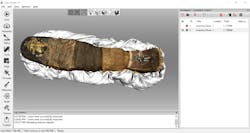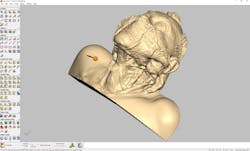3D scanning is enabling advances in medicine, science, history, education and manufacturing as it provides an innovative and unique approach to digitally capture a myriad of objects. Depending on the industry, these objects can range from animals’ prosthetics to million-year-old mummies to U.S. presidents and even cadavers. The global 3D scanning market is expected to be valued at USD 8.04 billion by 2025. As more industries, from education to healthcare, turn to 3D scanning technology, the use-cases for 3D scanning will continue to expand. With such an impactful technology, it’s important to understand its benefits, limitations, common uses and, ultimately, how to choose a 3D scanner.
Benefits and Limitations of 3D Scanning
Professional handheld 3D scanners offer a wide range of benefits and, depending on what the scanner is being used for, it can save time and resources. Users of the technology have also found a special niche use for it in recreating designs and parts that may no longer exist. For example, if you’re repairing an old vehicle and need a specific part that is no longer available, 3D scanning can be used to reverse engineer a new part.
For the Dutch Royal Navy, this technology has been a saving-grace for older, discontinued or custom parts. Marinebedrijf Koninklijke Marine is the company that maintains the Dutch Navy’s ships and it’s common for it to not have a 3D CAD file for an old part that needs to be replaced. In this case, 3D scanning is used to reverse engineer the original part to create an exact replacement part.
In the healthcare field, 3D scanning has been praised for its ability to take accurate, noninvasive measurements of patients. For example, if a child needs a prosthetic limb, creating a plaster mold can require the child to sit still for lengths at time, whereas a 3D scanner can be used to quickly take a 3D scan of the limb.
While there are multiple benefits of using the technology, it does come with certain limitations that should be considered. Lighting can be an issue as it relates to accurately capture the data. In areas where lighting is either poor or too bright, it can be difficult to capture an object. For example, if you’re 3D scanning a fossil that’s been found in a desert, the sun might be shining very brightly, making the 3D scanning conditions not ideal. While this can provide some difficulties, 3D scanning technology is quickly making large strides in this area. Many of the more advanced scanners are well-suited to compensate for lighting conditions that are not ideal.
Another hurdle with 3D scanning can be the learning curve, especially as the use cases expand into industries where the operators might not have design or engineering backgrounds. These professional pieces of equipment require some knowledge and understanding of how the technology works for proper results. However, these technologies can quickly be learned with the proper training.
Additionally, the implementation of AI within scanners is eliminating some of the learning curve. Some 3D scanners and software offer features that allow users to track and monitor in real-time to see if the user has missed a section of the object during the scanning process. For handheld scanners, AI is also eliminating the amount of “noise,” or unwanted data, that is captured during the scanning process, as well as providing superior tracking technology that makes starting and stopping a scan a non-issue.
Scanning the Sherit mummy with Artec Eva, powered by Artec battery pack.
Common 3D Scanning Applications
A common use for 3D scanning is for quality control. Parts can be taken off an assembly line, 3D scanned, and compared with the original CAD file. This is an easy way for parts to be quickly checked to ensure what is being produced is in fact similar to the original design or intent. 3D scanners can also be used to detect imperfections or cracks in materials. For example, Thames Water, the UK’s largest water and wastewater services provider, uses handheld 3D scanners to inspect its water pipes.
Education is also an emerging area where interest in 3D scanning is growing. Across the globe, students are picking up 3D scanners to better learn about history, design, and art. At Mid-Pacific Institute in Hawaii, students 3D-scanned artifacts to create a virtual museum as part of their coursework. It offers an interactive and modern way for students to learn about the artifacts within their area. This practice of 3D scanning precious artifacts isn’t just an activity to engage students, but is based on a historical preservation movement within the scientific community.
For precious, historical artifacts that often cannot be touched or removed from their locations for further examination and studying, the artifact can be 3D scanned, creating a digital model which can be studied. Recently, 3D scanning and CT scanning collided to create a digital copy of the Sherit mummy which resides at the Rosicrucian Egyptian Museum in San Jose, Calif. Now, visitors of the museum can interact with a digital model of the mummy. This is one example of how 3D scanning has made it possible to virtually interact with objects that a person would otherwise never have access to, by creating a precise digital copy. In addition, these digital models have made it easier to share knowledge and collaborate on research. A scan of a unique fossil, or any other subject, can be instantly shared around the world with experts to provide their expert opinions on.
One of the main ways the technology is being used within the healthcare field is to create prosthetics for humans and animals alike. For example, in Phoenix, Ariz., an alligator was found without his tail and appropriately named Mr. Stubbs. However, researchers from Midwestern University and the Phoenix Herpetological Society, in conjunction with Stax 3D, used 3D scanning in combination with 3D printing to craft a prosthetic tail for Mr. Stubbs. By being able to accurately and precisely scan a missing limb, researchers can create exact replicas, saving time and money, and improving quality of life.
3D and VR technologies are growing ever more popular throughout industries all over the world and are becoming especially common in the healthcare field due to their precision, ease of use, and versatility. Another unique application in healthcare is using the technology to create virtual cadavers for students to study and use in class. At the Montpellier Medical University in France, medical students were facing a shortage of cadavers in order to learn about dissections. To compensate for the high demand for cadavers, the professors are using 3D scanning to accurately capture all dissection stages, as well as provide 3D photorealistic models to feed the application—creating a realistic virtual cadaver for the students to practice dissections on.
The 3D model of the Sherit mummy, created with Artec Eva 3D scanner, rendered in Artec Studio 12 software.
Selecting a 3D Scanner
If you have a project that you feel could benefit from 3D scanning, the process of selecting the right technology can feel like a daunting task. When determining which 3D scanner is best for a project, it is most important to consider how the scanner will be used, rather than the technology inside it and how it works. For instance, if you need to scan a very small object, you will need to select a technology that can scan at a high resolution. If you are scanning an object from 100 meters, a long-range scanner will be needed.
Ease-of-use is another important consideration. How long will it take to get trained on the technology? Will you need to apply markers to the object you are scanning? How easy will the process be in general? Reading reviews of the scanner and industry forums can provide much of this information.
Another question to ask is should you be using a consumer-grade or professional-grade scanner? In addition to differences in accuracy and resolution, a major difference between consumer-grade and professional-grade 3D scanners has to do with the support of the manufacturer. With consumer scanners, there is little support for the end-user in terms of providing maintenance. The relationship often ends after purchase. Professional scanner brands know they need to be able to provide ongoing support to ensures their scanning technology can deliver optimal performance on a long-term basis.
As a rule of thumb, a professional 3D scanner should last about 10 years. This makes the scanner’s accompanying software a significant factor in picking a scanner. This is a space that is rapidly advancing, so a regular cadence of software upgrades is needed to keep pace.
When selecting a scanner, nothing can compare to testing it in person. If purchasing a professional 3D scanner is the route you choose to go, invest in attending an event where the technology will be. If you can, bring the typical part you will be scanning to the booths of exhibiting companies and see firsthand the results and watch as they conduct the scans. Compare the workflows, processing, and final models of each scanner to make the most informed decision possible.
3D result of a neck dissection step using Freeform for digital sculpting.
Future of 3D Scanning
3D scanning technology is advancing at a rapid pace. The future of the technology is rooted in its incorporation of AI to make the process more intuitive and the blending of scanning and processing into one device for convenience. With the adoption of AI capabilities, 3D scanners will not only be able to intuitively and easily track when an object is being scanned, but even be used to make subjective decisions. For instance, in the future, when the 3D scanners are used to inspect the exteriors of aircrafts, the scanner itself will be able to discover any dents or imperfections and determine which areas will need repair work and which areas don’t pose any safety concerns. However, in the shorter term, AI is going to continue to make 3D scanning as easy as taking video with a cell phone.
Seemingly each day new use-cases for 3D scanning are discovered. Knowing how the technology works, the benefits and limitations, and the current common uses is just the first step in discovering a new application for the technology and disrupting an industry’s status quo.
Andrei Vakulenko is chief business development officer for Artec 3D.




